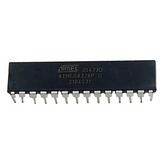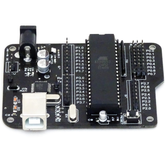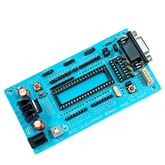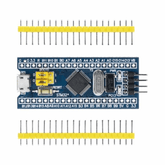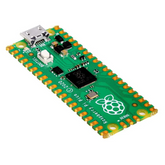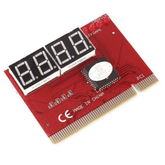Understanding All Microcontroller Types and Applications
Summary
If you’ve ever wondered how a washing machine knows when to stop spinning or how your smartwatch tracks your heartbeat, the answer lies in a small but mighty device called a microcontroller.
Microcontrollers bridge the gap between the physical and digital worlds. They are the brains behind the scenes in robots, vehicles, medical devices, and home appliances.
Understanding the different types of microcontrollers and their functions can help you create better more efficient designs. Let’s dive deep into how these fascinating chips work, how they are classified, and what the future holds for them.

What is a Microcontroller?
A microcontroller is a compact integrated circuit designed to perform specific control functions in an embedded system. It’s a tiny computer on a single chip, but with one key difference: it’s optimized to control devices rather than to perform general-purpose computing.
A typical microcontroller chip contains:
- A CPU (Central Processing Unit) for processing instructions
- Memory (RAM, ROM, or Flash) for storing data and programs
- I/O ports for interfacing with sensors, displays, and actuators
- Timers, counters, and communication interfaces such as UART, SPI, and I²C
These built-in components make microcontrollers self-sufficient units capable of running specific tasks with minimal external circuitry.
How does a Microcontroller Work?
The function of a microcontroller can be summarized as sensing, processing, and acting. These three stages form a continuous feedback loop that enables a device to interact intelligently with its environment.
- Input Stage – It reads signals from sensors or input devices (like buttons or temperature sensors).
- Processing Stage – The CPU interprets the data based on the program stored in its memory.
- Output Stage – It sends signals to actuators or output devices, such as LEDs, motors, or displays.
For example, in an automatic light system:
- The microcontroller reads data from a light sensor.
- It processes the data to determine if it’s dark.
- If the light level is low, it sends a signal to switch on a lamp.
This entire process happens in milliseconds, making microcontrollers the ideal control center for real-time applications. Their ability to execute instructions at high speed while consuming very little energy is what makes them indispensable in modern embedded designs. This entire process happens in milliseconds, making microcontrollers the ideal control center for real-time applications.
Classification of Microcontrollers
Microcontrollers can be categorized in several ways depending on their architecture, bit size, or application domain. This classification helps engineers choose the right controller for specific performance and cost requirements.
1. Based on Architecture

- Harvard Architecture: Has separate memory spaces for data and program instructions, allowing simultaneous access. Used in PIC microcontrollers.
- Von Neumann Architecture: Uses a single memory for both data and instructions. Common in ARM-based microcontrollers.
This division forms the foundation of microcontroller architecture, influencing how quickly data can be fetched and processed. The choice between these architectures often depends on the balance between simplicity and performance.
2. Based on Bit Size
- 8-bit Microcontrollers: Handle 8-bit data at a time. Simple, low-cost, and ideal for basic applications (like the Intel 8051).
- 16-bit Microcontrollers: Offer higher precision and better performance, suitable for automotive systems.
- 32-bit Microcontrollers: Power modern devices such as smartphones and drones with advanced processing capabilities.
The bit size determines how much data a microcontroller can process per cycle, directly affecting speed, precision, and overall functionality. Higher-bit microcontrollers often support more memory and peripherals for advanced use cases.
3. Based on Memory Configuration
- External Memory Microcontrollers: Use external memory for storage (less compact).
- Embedded Memory Microcontrollers: Have built-in memory, making them faster and more compact.
4. Based on Application
- General-purpose Microcontrollers: Found in home appliances and industrial tools.
- Special-purpose Microcontrollers: Used in robotics, medical equipment, and automotive systems.
Popular Microcontroller Families
Several microcontroller families dominate the embedded electronics world. Each has unique strengths, hardware configurations, and community ecosystems that make them suitable for certain applications.
1. 8051 Microcontrollers

- Developed by Intel, this is one of the oldest and most widely taught Microcontroller Types.
- Architecture: 8-bit Harvard.
- Features: 4KB ROM, 128 bytes RAM, and up to 40 I/O pins.
- Applications: Keyboards, LED controllers, and consumer electronics.
Despite its age, the 8051 remains a benchmark for learning embedded design principles. Its simplicity and reliability make it an enduring favorite in academic and low-cost commercial projects.
2. PIC Microcontrollers

Designed by Microchip Technology.
- Architecture: Harvard with RISC (Reduced Instruction Set Computing).
- Advantages: High-speed processing, low power consumption, and versatile I/O options.
- Applications: Robotics, automation, and data logging.
PIC controllers come in a wide range of models, making them adaptable to both beginner projects and industrial-grade automation systems. Their modular peripherals simplify sensor integration and communication setup.
3. AVR Microcontrollers
- Developed by Atmel (now part of Microchip).
- Architecture: Modified Harvard, 8-bit or 32-bit.
- Special Feature: Flash memory allows reprogramming multiple times.
- Used in: Arduino boards, making them beginner-friendly for prototyping and IoT projects.
AVR chips strike a balance between ease of programming and performance. Their compatibility with open-source platforms makes them a key driver of the maker and DIY electronics movement.
4. ARM Microcontrollers

- Based on ARM’s RISC architecture.
- Bit Size: 16/32-bit cores, widely used in Microcontroller units (MCUs) for high-performance applications.
- Features: Low power usage, high processing speed, and support for advanced peripherals.
- Applications: Smartphones, drones, automotive ECUs, and industrial automation.
ARM microcontrollers dominate the modern embedded landscape thanks to their scalability—from low-power Cortex-M0+ units to high-performance Cortex-M7 chips used in complex control systems.
5. MSP430 Microcontrollers
- Developed by Texas Instruments.
- Architecture: 16-bit RISC.
- Features: Ultra-low power consumption, ideal for battery-powered devices.
- Applications: Smart meters, wearable devices, and sensors.
The MSP430 family shines in applications where long battery life and energy efficiency are critical. Its integrated analog peripherals and flexible clock systems make it a favorite in portable and medical electronics.
6. Raspberry Pi Pico (RP2040)
- Built on a dual-core ARM Cortex-M0+ processor.
- Highlights: High-speed I/O, flexible programmable pins, and large Flash memory.
- Applications: IoT devices, robotics, and educational projects.
The Raspberry Pi Pico brings powerful computing to small-scale projects. With its accessible price and open hardware design, it’s redefining what’s possible in the world of embedded education.
Each family differs in performance, power efficiency, and ease of programming—key aspects to consider when selecting the right one for your project. Understanding these nuances allows you to balance cost, power, and processing needs effectively.
Applications of Microcontroller
Microcontrollers are used practically everywhere, embedded invisibly into the heart of modern life. They handle control operations that humans rarely notice but rely on every day.
Common Application Areas:
- Consumer Electronics: TVs, washing machines, microwave ovens.
- Automotive Systems: Engine control, airbag deployment, and automatic braking.
- Industrial Automation: Motor control, temperature monitoring, and machine safety.
- Healthcare: Pacemakers, blood pressure monitors, and diagnostic instruments.
- Aerospace & Defense: Drones, navigation systems, and missile guidance.
- IoT Devices: Smart home systems, wearable trackers, and energy management tools.
From thermostats to robots, the components used in a microcontroller—CPU, memory, and I/O peripherals—enable efficient control over both simple and complex processes.
How to Choose the Right Type of Microcontroller for Your Project
Selecting the right Microcontrollers Types depends on your project’s specific needs. Here’s how to decide:
- Determine Processing Power: Choose between 8-bit (simple tasks) and 32-bit (complex tasks).
- Check Memory Requirements: More memory means more space for your program and data.
- I/O Needs: Consider the number of input/output pins for sensors or motors.
- Power Consumption: For battery-powered applications, opt for ultra-low-power models like MSP430.
- Programming Support: If you’re a beginner, use platforms like Arduino (AVR-based).
- Budget: Cost-effective models such as PIC or STM32 offer excellent value.
The choice ultimately depends on balancing cost, performance, and energy efficiency. A well-chosen microcontroller chip can dramatically improve a product’s reliability, simplify design, and reduce development time.
Future Trends in Microcontroller Technology
The world of microcontrollers is evolving fast. Several emerging trends are reshaping how we design and use them:
- AI-enabled Microcontrollers: Tiny ML (Machine Learning) on devices like ARM Cortex-M allows real-time decision-making without cloud reliance.
- IoT-focused MCUs: With built-in Wi-Fi, Bluetooth, and security modules, these enable smarter and more connected devices.
- Energy Harvesting Systems: Future microcontrollers will operate on ambient energy sources like solar or motion.
- Quantum and Neuromorphic Architectures: Experimental designs aim to mimic human brain efficiency for complex control systems.
These advancements point toward a future where microcontrollers not only control but also “think” locally. They’ll enable edge computing, faster response times, and more sustainable energy use, all critical for the next generation of intelligent devices.
Conclusion
Microcontrollers are compact, efficient, and incredibly versatile devices. They empower devices to sense, process, and act, transforming simple circuits into smart systems. From 8-bit 8051s to powerful 32-bit ARM processors, the evolution of microcontroller architecture continues to fuel innovation across industries.
As AI and IoT technologies expand, the next generation of microcontrollers promises not just control but cognition, bringing intelligence to everything from kitchen appliances to autonomous drones.



